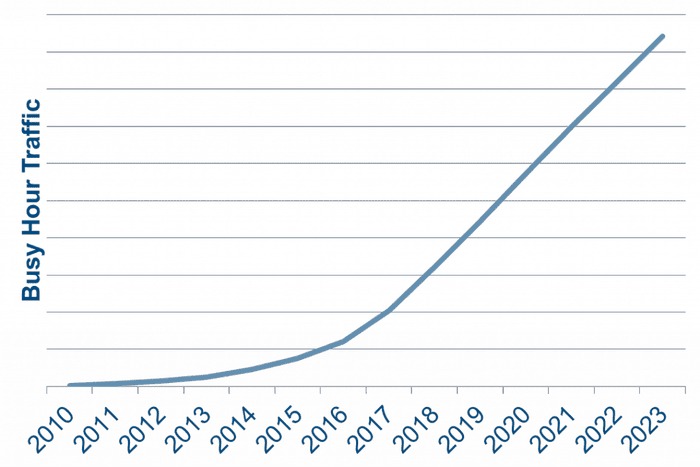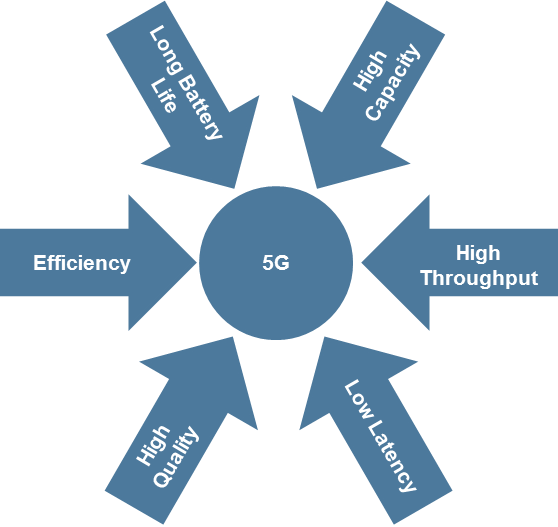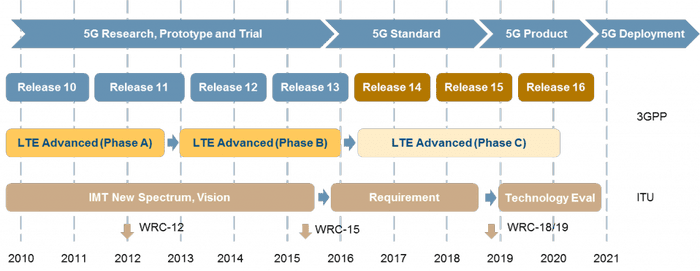5G - is this the technology that will deliver the ultimate mobile experience?
Despite the uncertainties of what types of applications and the levels of traffic that will be prevalent after 2020, it seems to make sense to plan and standardise now for the next generation of mobile technology. However, pinning our long term technology and spectrum requirements on the forecast growth in usage based on current mobile applications and services may be flawed.
March 24, 2015

Telecoms.com periodically invites expert third-party contributors to submit analysis on a key topic affecting the telco industry. In this article Phil Roberts, Managing Consultant at Coleago Consulting, provides an overview of current state of affairs in the development of 5G, and discusses the various technological considerations and challenges related to the next generation mobile technology.
Introduction
Mobile network operators around the world are experiencing huge growth in mobile data traffic and forecasts suggest that over the coming years it is set to rise even more dramatically.

Figure 1: typical mobile operator traffic growth forecast
Many operators are already experiencing capacity issues in the populated areas where traffic density is at its highest. The so called ‘capacity crunch’ where operators struggle to meet demand with the required quality of service can be alleviated through provision of additional spectrum or building additional capacity sites to soak up traffic.
However, operators are now finding it very difficult to build new traditional macro cell sites, especially in built up areas due to planning constraints and the current high cell densities. The short to medium term solution is to acquire more spectrum, and build out 4G small cell solutions to soak up capacity in built up areas and at traffic hot-spots.
Coleago analysis indicates that 4G LTE deployment using current and near term spectrum allocations may support the typical operator traffic forecasts in the medium term to 2020. However, there is little scope to acquire the required amounts of additional spectrum compatible with 4G LTE technology if growth continues at these rates.
There is plenty of additional spectrum available above 6 GHz that could be used for mobile operator small cell solutions. However, 4G technology was developed to operate in the bands below 6 GHz and optimised for around 2 GHz.
In order to make use of the large amounts of spectrum between 6 GHz and 100 GHz new ‘5G’ radio access technologies that are optimised for small cell solutions operating at these high frequencies will be required.
The coverage range at these high frequencies is very limited and therefore not suitable to provide wide area coverage. 5G technology will therefore likely be focused on very high capacity small cell solutions and the co-existence/interworking with other network technologies and bands currently used for 3G and 4G deployment.
However, 5G is not just about the new radio access technologies required to operate on these higher frequency bands. There are a number of other drivers requiring a generational step change in mobile communications technology.
Key Drivers behind 5G mobile technology
The drivers for 5G go beyond the need just to support additional higher band spectrum. The key drivers behind 5G are outlined below and illustrated in Figure 2.

Figure 2: Key Drivers for 5G
High Capacity – Many operators are already experiencing a ‘capacity crunch’ and are alleviating this through acquisition of new spectrum, re-farming of existing spectrum used for 2G and 3G, and where possible, installation of new macro and small cell sites. However, with traffic levels growing so fast, it is highly likely that operators will encounter future capacity issues at a time when they can no longer gain access to any suitable additional spectrum for LTE 4G, or have any scope to densify their network in the traditional way in the main population centres.
It is also easy to imagine how traffic levels could escalate beyond current industry forecasts with the ever increasing trend for devices, video services and data applications that consume higher and higher bandwidths. Also, the numbers of devices on a network generating traffic could rise exponentially if connectivity of embedded devices takes off. ‘The Internet of Things’ could include vast numbers of embedded devices such as bio chips, automobile sensors, smart metering etc that, whilst individually have relatively low data rates, the sheer volume of devices may create capacity issues.
High Throughput – The average throughput achieved by users is a better indicator of quality than the headline peak data rate offered by a technology and its allocated spectrum. However, the combination of increasing the peak data rates and deploying small cells will provide higher average throughputs resulting in a far better user experience. 5G could potentially deliver data rates up to 10 Gbps with typical user data rates of around 1 Gbps. These sorts of throughput will be required if there is demand to deliver quality levels approaching that of the fixed network fibre connection. Providing wireless connections at these speeds creates the opportunity to deliver advanced applications and services such as virtual and augmented reality, Ultra High Definition video conferencing and fast access cloud based services over mobile networks.
Low Latency – Latency is the round trip delay experienced by the user whilst accessing/using an application or service on their mobile device. Whilst LTE 4G provides much improved latency compared to 3G technology, the delays are still too high for many real time applications. The aim with 5G is to reduce latency to less than 1mS. A latency of 1mS and less will be required for ‘tactile internet’ applications where perceived instant response time is achieved when interacting with virtual reality and augmented reality software systems. Also, mission critical machine to machine real time control systems will require very low round trip delays in order to operate effectively and safely.
High Quality – High Capacity, high throughput and low latency all contribute significantly towards a high quality user experience. However factors such as resilience, reliability, availability and security also impact significantly on the perceived quality of service. 5G radio access and core systems will need to be engineered to provide the appropriate levels of service quality and availability. 5G will also need to ensure that a seamless user experience is achieved when moving across different areas and technology segments within the network. The 5G radio interface may only be deployed in some parts of the dense urban and urban areas with 4G LTE providing coverage and capacity elsewhere. Seamless interworking will be required to transition between the different radio access technologies and cell hierarchies within the network.
Efficiency– 5G will need to enable cost efficient high density small cell capacity solutions. The total capex and opex required to install and operate 5G small cell systems will need to be lower than current 4G small cell solutions so that network operators adopt 5G as their priority capacity solution. Provision of backhaul to high numbers of small cells is often a cost issue for network operators. Along with the development of the 5G radio access air interface, vendors will need to provide innovative cost effective small cell backhaul solutions. This could include ‘self-backhaul’ for small cells whereby the small cell integrates the radio access interface with a wireless backhaul and self-organising inter-node functionality.
5G network infrastructure and devices will also need to be very energy efficient. There is continuing pressure to implement ‘greener’ infrastructure solutions and the energy consumption per bit becomes very important in determining the total power consumption of devices and resultant battery life. With large amounts of spectrum in the centimetre and millimetre bands being available, more focus may be put on energy efficiency at the expense of spectral efficiency when designing 5G radio access interfaces.
Long Battery Life – As mentioned above, a key requirement for devices is energy efficiency which becomes very important for devices that require a long battery life. These could include sensors and meters requiring a battery life of up to 10 years. Battery life is therefore extremely important if the vision of the ‘Internet of Things’ is to be realised.
5G Standardisation and Technology
As with 3G and 4G mobile network technologies, 5G will be standardised through the 3rd Generation Partnership Project (3GPP), the cellular communications standards organisation.
Figure 3 below shows a proposed time line for development of the 5G standards and subsequent product introduction in relation to the 3GPP LTE standard releases. Releases 14, 15 and 16 will include standardisation for 5G technology.

Figure 3: 5G Standardisation Timeline (Source Huawei)
The ITU are also working in parallel with 3GPP and will finalise their vision for 5G during 2015 and deliberate on additional spectrum requirements during the forthcoming World Radio Conference WRC-15.
Along with the telecommunications vendor community, many other leading industry bodies are supporting the development of 5G technology. These include the European Commission via the 5G Private Public Partnership (5G PPP), the University of Surrey 5G Innovation Centre, EU project METIS (Mobile and wireless communications Enablers for the Twenty-twenty Information Society) and 4G Americas.
The standardisation and subsequent vendor 5G products are likely to consider a number of advanced technology options in order to deliver the required features and functionality. Advanced technology areas being considered include:
Advanced radio access modulation schemes optimised for centimetre and millimetre wave bands such as Universal Filter Orthogonal Division Frequency Multiplexing (UF-ODFM) also known as Universal Filtered Multi-Carrier (UFMC)
Massive Multiple Input Multiple Output (MIMO) antenna schemes
3D MIMO schemes for dense urban high rise environments
Virtualised cloud based radio access network control and processing
Software defined networks
Advanced inter-node coordination to minimise interference
Multi radio access technology integration and management
Device to device communication
Backhaul integration
Just because the standards have been developed doesn’t mean that fully featured 5G technology will be widely deployed. There are many standardised features in 4G LTE that have not yet been widely deployed on a commercial basis. Also, many network operators are conservative when it comes to adopting new technology early in the product life cycle, preferring to wait until network infrastructure and devices are more established in the market place.
5G is unlikely to be a replacement for 4G LTE but more of a complementary technology delivering features and functionality that 4G either can’t provide, or deployed in areas where 5G provides a lower total cost of ownership. 4G LTE will remain an extremely good technology at delivering wide area mobile broadband coverage via traditional macro and micro sites and has a well-defined development path via the LTE-Advanced roadmap.
Spectrum for 5G
As outlined in the introduction, a significant amount of new spectrum is required for 5G deployment. Figure 4 below shows the proposed centimetre and millimetre bands proposed for 5G along with some potential for 5G below 6 GHz.

Figure 4: Potential Spectrum Allocation for 5G (Source: Nokia)
The spectrum below 5 GHz is also a candidate for the evolution of 4G LTE-Advanced and LTE Licence Assisted Access (LTE LAA) spectrum as a wifi substitute for commercial network operators.
Spectrum above 10 GHz is most attractive for 5G due to the large bandwidth available giving most benefit in terms of capacity and throughput. However, this centimetre and millimetre wave spectrum will not be allocated until after the ITU WRC-19 conference.
Whilst most current spectrum allocations are now technology neutral and can be used for 2G, 3G, 4G and any future mobile technologies, it is unlikely that the centimetre and millimetre bands could operate effectively using the legacy radio interface designs. These bands would therefore be deployed using a new 5G radio interface optimised for these high frequencies.
At this stage, the prospect of additional spectrum being made available after 2019 in the centimetre and millimetre bands is unlikely to have any significant impact on the valuation of any spectrum awarded before this date used for 3G and 4G deployments.
Any additional spectrum awards to 2019 are likely to be below 5GHz and some allocations will have the potential to be deployed across macro, micro and small cell nodes whereas spectrum in the centimetre and millimetre bands will be limited to very small cell solutions only.
However as we move towards 2020 it will be important to get a clearer view on the traffic that will be generated by 4G and 5G devices, and how this traffic will be distributed across the 4G and 5G network infrastructure. The degree of reliance on 5G to support this traffic mix along with its associated costs will have a large influence on the value of the centimetre and millimetre wave spectrum values.
Operator Challenges
Network operators face a number of challenges leading up to the introduction of 5G technology. 5G is likely to be focused around dense deployments of small cells whereas today most networks are dominated by large macro sites with relatively few small cells. Network operators will need to carefully plan their network architecture strategy and spectrum deployments in order to cope with the potential widespread deployment of small cells in dense urban and urban areas. Those network operators who have already introduced a significant number of 4G LTE small cell solutions into their networks may have a competitive advantage when it comes to introducing 5G. These operators are likely to have a better understanding of the technical issues around interworking of small cells with the macro network layer, performance gains and the small cell cost structure.
With the continual pressures on containing capital and operating costs, network operators will need to fully understand the business case for small cell deployments and the introduction of 5G technology. They will need to have a clear understanding of when and where in the network 5G deployment will be economically viable and add value to their business.
Summary
Despite the uncertainties of what types of applications and the levels of traffic that will be prevalent after 2020, it seems to make sense to plan and standardise now for the next generation of mobile technology. However, pinning our long term technology and spectrum requirements on the forecast growth in usage based on current mobile applications and services may be flawed.
We may see a demand for a whole range of advanced applications that require very low latency and high throughput. Also, however wide and fast we make the mobile broadband pipe, advanced applications will be dreamt up that consume network and user device resources to their absolute limits. Therefore, a visionary approach is needed for 5G to ensure that user devices, radio access, transmission, and core network resources flexibly align in an economic, geographic and time specific way in order to service a wide range of traffic types and volumes.
5G technology will doubtless help in delivering the ultimate mobile experience but only if it adds to what LTE and its planned evolution can do, integrating seamlessly into the network to provide a consistently better user experience.
Phi l Roberts is a Chartered Engineer and Managing Consultant at Coleago Consulting Ltd. Coleago is a specialist telecoms strategy consulting firm specialising in spectrum valuation and auction bidding strategy. Coleago has worked with operators around the world to address the current challenges in spectrum valuation.
l Roberts is a Chartered Engineer and Managing Consultant at Coleago Consulting Ltd. Coleago is a specialist telecoms strategy consulting firm specialising in spectrum valuation and auction bidding strategy. Coleago has worked with operators around the world to address the current challenges in spectrum valuation.
Read more about:
DiscussionAbout the Author
You May Also Like


.png?width=300&auto=webp&quality=80&disable=upscale)







.png?width=300&auto=webp&quality=80&disable=upscale)


_1.jpg?width=300&auto=webp&quality=80&disable=upscale)